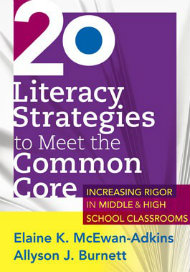20 CCSS Literacy Strategies
20 Literacy Strategies to Meet the Common Core:
Increasing Rigor in Middle & High School Classrooms
By Elaine K. McEwan-Adkins and Allyson J. Burnett
(Solution Tree Press, 2013 – Learn more)

20 Literacy Strategies to Meet the Common Core is built on the Common Core Anchor Standards for Reading, Grades 6-12. Elaine McEwan-Adkins and Allyson J. Burnett lay out a blueprint for ELA and other content-area teachers to follow. (Be sure to read the preface to discover how these two instructional experts met and then collaborated to write this book.)
My goal in this review is to provide a level of detail that will help teachers and others in instructional leadership roles decide whether to invest in this CCSS resource.
Preface and Introduction

- strategies aligned to CCSS for reading informational text
- encouragement & support to teach all students how to read to learn
- topics for discussion & reflection in PLCs and teacher teams
Those goals (page xiii), along with their suggestions for How to Use This Book to Advance Schoolwide Content Literacy (pages xiv-v), support a school in moving forward with the literacy demands of the Common Core.
For my non- ELA teacher friends who may be nervous about the literacy demands of the Common Core, the authors provide practical support throughout the book.
McEwan-Adkins and Burnett have packed so much of value into these strategy lessons. The arrangement of the 20 strategies into four sections based on the four broad categories of the CCCC Anchor Standards for Reading is also beneficial to a teacher. I am pleased that the strategy lessons are formatted the same throughout the book.
An Overview of a Strategy
Each of the 20 literacy strategies includes these six components:
Strategy Name – The names are usually self-explanatory – Strategy 2: Show You Know; Strategy 3: Prove It; Strategy 7: Snapshot Summary; Strategy 14: Identify-Analyze-Relate (Problem-Solution) or Strategy 17: Navigate-Integrate-Evaluate. But don’t be fooled by the seemingly “simple” strategy names. The strategy lessons require ample preparation time for in-depth understanding by both teacher and student.
Gist Statement and College and Career Readiness Anchor Standards – This is a short description of the strategy along with an extension or enhancement activity called the +feature. The +feature pushes students to higher-level thinking and writing as a response to text. I was pleased that the complete standard is included in each chapter; the part of the standard addressed in the strategy is italicized.
Background Knowledge – Here teachers find detailed explanations regarding the processes used in the strategy. For example, in Strategy 13: Weigh the Words, the focus is on interpreting and analyzing word choice (Anchor Standard 4 for Reading). The authors provide background information on technical vocabulary, connotative vocabulary, and figurative language. McEwan-Adkins and Burnett tell readers on page 12 that the Background Knowledge “may not be essential to your implementation of the strategy, but having it will help you make connections to things you have read about and done in the past.”
Understanding How the Strategy Works – This section contains a sample text, complete with Flesch-Kincaid grade level, and a sample organizer. The organizer, which is completed, is designed to lead the teacher through the process of reading the sample text and understanding the strategy. Do not miss the statement on page 12: “These resources are intended for you, not your students.” This is your preparation prior to teaching the strategy.
Items to Prepare – The handouts needed for the strategy are downloadable from http://www.solution-tree.com/literacy-strategies-common-core.html Each strategy includes a page of student-friendly definitions for the strategy and an organizer. Most strategies require two or three reproducible resources; however, Strategy 12: Quick-REACH Vocabulary Toolkit has seven reproducible pages. It is important to note that this preparation is continued in Step 1 of the lesson plan.
Lesson Plan – The lesson plan contains seven steps along with annotations or reminders to guide you in the lesson.
Lessons Step by Step
Now let’s take a closer look at the lesson planning steps.
Step 1 in each strategy is critical; the teacher must “select content-specific and standards-aligned text from his/her content to use in teaching the strategy.” Once selected, the teacher will need to “chunk, highlight, or number sentences in the text as directed in the lesson plan.” The selected text is chunked into three sections which is central to Step 4 of the lesson plan. In addition, teachers may need to photocopy the text along with other reproducible resources required in the lesson.
In Step 2, the teacher identifies the related content standard(s), whether from the Common Core or other appropriate source.
Step 3 of the Lesson Plan includes an advance organizer (a hook) for the strategy. This involves reviewing the student-friendly definitions and sharing a brief anecdote. In Strategy 5: Question Like an Investigative Reporter, the advance organizer references mild-mannered Clark Kent who had a nose for news when he wasn’t busy being Superman.
The bulk of the instruction is found in Step 4. Here you model your thinking with the first chunk of text. In other words, think aloud so your students can see and hear how a reader processes informational text. Gradually release responsibility to students with Chunks 2 and 3. The goal is for students to understand and apply the strategy independently. The amount of time and support required will depend on your students.
In Step 5, the teacher is formatively assessing student work. The assessment might include a display of responses to the question prompts “how the events develop and interact” and “why the events develop and interact” in Strategy 10: What-How-Why (Events). In other lessons, the teacher might facilitate a conversation to check for accuracy on the organizer.
Teachers then have two options: continue to Steps 6 and 7 or incorporate the +feature before doing those last two steps. In Step 6, students reflect on their learning from the text; in Step 7, they reflect on their level of understanding of the content standard(s).
In summary . . .
20 Literacy Strategies to Meet the Common Core presents research-based strategies designed to grow readers and thinkers on the secondary level. This book’s cover says it all: literacy strategies, Common Core, rigor, middle and high school! What the cover doesn’t say is how much time it will take a teacher, team or department to develop and design content-specific lessons for these strategies. However, as the national focus shifts to more challenging standards in the United States, I believe teachers will find the ideas and advice in this book worth the time investment.
Anne Anderson finally got out of the 8th grade after 24 years and 9 weeks! She spent the next 9 years sharing her expertise in literacy and writing with K-12 teachers and administrators throughout the district. She credits National Writing Project and Poetry Alive! as turning points in her growth as a teacher. She now shares her expertise nationwide as an Educational Consultant and through her bi-monthly newsletter Spotlight on Success. Subscribe at anneanderson@bellsouth.net.


































